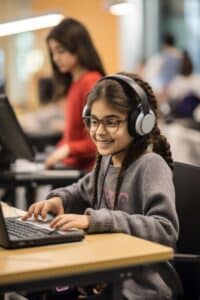
With differentiated instruction, learning goals remain the same, but students progress through the materials at different speeds and with different supports. This allows teachers to consider the specific needs, skills and profiles of their learners based on their interests, and the particular way each student learns. When learners have access to differentiated and tailored instruction, this can have a positive impact on behavior and skill acquisition.
Differentiation is often used in our daily lives when we have different ways of accessing information. Listening to a book on tape vs. reading the written word, using speech to text to send a text message to a friend, moving frequently used kitchen items to a lower shelf to be easily reached or increasing the size of the text on our phone are all examples of differentiated information. We are accessing the same context, just in different ways, and ways that make it more accessible.
When students are presented with a curriculum that meets their needs, it allows students to access the same information as their peers independently and as effectively as possible. Differentiating the instruction provides access to material in a way that is best suited for their learning style and skill. When students access material or information with support that meets their needs, they will be more likely to feel successful and can help facilitate motivation to learn.
In special education, there are a lot of complexities that teachers and support staff have to take into consideration with the variety of student needs, skills and learning styles that they encounter. Students may have physical or motor limitations, hearing or vision impairments, or limited adaptive or developmental skills to take into consideration. Because of these complexities, individualizing the instruction and support is a valuable and sometimes necessary tool to support student learning. We must also consider how a student interacts with the variables in the environment, as well as a student’s learning history. When we are providing support and material that matches a learner’s interests, we can make learning fun! For example, if a student loves animals, using animals as math manipulatives can motivate that student to fully participate and connect with the material. Differentiated learning helps students access materials and instruction and lay the groundwork for learning.
Although differentiation can sometimes be time consuming and may require some additional assessment, there are a variety of ways in which instruction can be differentiated to assist learners with materials or tools that are accessible in the classroom.
Differentiating instruction can involve simply altering the physical environment, method of delivery and altering the physical materials. Since each student has a unique set of interests and needs, we have to remember that differentiation is not a “one size fits all” approach, and what works best with one student may not be effective with another, and not all students will need the same type of differentiation. However, research has provided some insight into best practices for differentiation that can facilitate student learning across a variety of classrooms, specifically differentiating through content, process, product and the physical learning environment.
Differentiating content can look like:
Process of teaching to present the content differently:
Product (modifying materials):
Differentiating the learning environment or layout of the classroom:
Using technology:
Although differentiation is a valuable tool in the classroom, we should always keep independence top of mind when looking at how student learning and support look long term and across environments. Additionally, we should always collaborate with stakeholders and the student’s IEP team to consider long-term and short term goals.
First we have to consider if the supports and differentiated instruction are sustainable, as well as how to gradually fade out supports if we can, including adult support. For example, when a student moves on to a new classroom or new teacher, can these same supports easily be put into place? Can materials be made available across environments? Remember that if we need to make changes to these supports or if some are not effective, that’s ok!
We can follow the student’s lead to tell us what is helping them learn.
Contributor Bio
Ann Lodolini-Kho, M.A.T, BCBA, has worked in the clinical and educational setting since 2003, beginning her career as a paraeducator and an interventionist providing direct ABA services. After earning her California Moderate/Severe Teaching credential in 2009, she worked for 7 years as a consultant providing behavior and educational services as part of the IEP team for a variety of Public School Districts across 6 counties in the San Francisco Bay Area serving students pre-K through age 22. After becoming a Board Certified Behavior Analyst (BCBA) in 2014, she stepped into the role of a supervising clinician for an ABA service provider, and a consultant for adult group homes. For 2 years, Ann was the Director of ABA services for a home and clinic based ABA provider, designing interventions for and overseeing the transition of services from early start to insurance funded ABA services. Prior to coming to TeachTown in 2021, Ann worked for over 3 years as a Behavior Specialist for a public school district in Northern California. Ann earned a Bachelor’s Degree in Psychology from University of the Pacific in 2005 and a Master’s in Special Education with a concentration in Emotional & Behavior Disorders from Walden University in 2009.